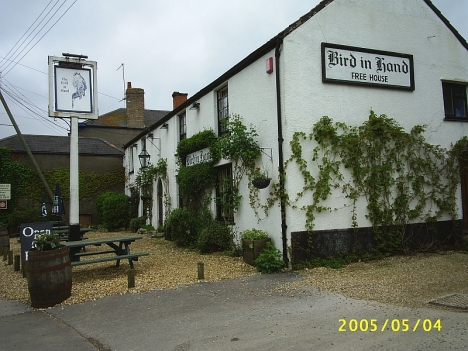UK trip 12 May 2005: Edinburgh to Stockton-on-Tees | Khanya
After spending the night in Stockton-on-Tees with Chris and Nina Gwilliam, old friends from Durham University, I woke up about 3:30 am, and went downstairs to write up my diary. Nina came down just after 6:00, and we chatted until Val and Chris got up. It seemed an appropriate place for them to be living, as Chris was a railway enthusiast, and Stockton was the terminus of the first commercial railway line. He made his living painting model railway rolling stock in the authentic livery of various periods. We left just after 9:00.
We drove to Leeds to see Pat and Rita Hayes. It was an uneventful drive along main roads and motorways, and the countryside looked much as it did down south, with fields of bright yellow rape seed alternating with pasture. The only difference was that here the roads tended not to be sunken, so one had less of a trapped-in feeling, of driving at the bottom of a furrow.
Patrick Hayes was my second cousin, and had retired after working as a microbiologist and food chemist for Birds Eye foods. He and Rita looked much the same, though 14 years older than when we had last seen them, when they stayed with us in Pretoria in 1991. Pat had had a pacemaker fitted to his heart, and was beginning to suffer from Parkinsons’s disease. Their son Stephen and his wife Cordelia were adopting another child, a girl aged 3, and were hoping to adopt a third. They were enjoying being grandparents as much as if it had been their own biological grandchildren.
We had lunch with them, of soup and salad, and left just before 2:00, and drove around a bit looking for the road to Hull, and eventually after getting caught up in quite a bit of traffic found the M62 motorway, and drove east, then turned down the M18 and went as far as Thorne, where the Vause family had lived.
My grandmother Lily Vause had married Percy Hayes in Johannesburg in 1904, and both she and her father Richard Wyatt Vause, had been born in Natal, so we knew of no living relatives on the Vause side of the family in England that we could visit. We did know that my great great grandfather, Richard Vause, had been born in Hull, but his ancestors had come from the Isle of Axholme in north-western Lincolnshire, and that was where we were headed. If there were no living relatives, we hoped to see some traces of dead ones. Actually the family moved around a lot, and so we said that they came from Humberside, though using that term seemed to get some English people riled up, and they insisted that there was no such place. People came from Yorkshire, or Lincolnshire, but never from a horrible artificial entity called Humberside. Nevertheless, the Vause family had lived, at various times, in Fishlake and Thorne in Yorkshire, and Crowle and Epworth in Lincolnshire, and “Humberside” seemed to cover them all. A useful resource for Isle of Axholme ancestry is the Red1st site.
We could not find the church at Thorne, and the traffic was quite heavy, so we drove on to Crowle, and looked at St Oswald’s churchyard. All the tombstones had been laid flat on the ground in a corner of the churchyard, and were hard to read, partly because one had to stand on them to read them, and partly because they seemed to get more worn and more mossy. We found a couple of Brunyee stones, but no Vause. The church itself was locked with a big padlock.
We drove through Belton without seeing the church, but found the church at Epworth, St Andrew’s, and took some photos of Hill graves, though they were probably not related (an earlier Richard Vause had married an Elizabeth Hill). There seemed to be a lot of Maw families, but no Vause.
The church is also of some interest in the history of Methodism. Samuel Wesley was the rector here, and his sons, John and Charles Wesley, were the founders of Methodism. John Wesley, like his contemporary St Cosmas the Aetolian, became an itinerant preacher.
We went to the town square and took some photos, and bought a copy of the local newspaper, but the woman who worked in the office was a Geordie from Newcastle.
From there we drove back to the A1 going south, and went as fast as we could to Harston, near Cambridge, where we stayed with Fr Michael and Jeanne Harper, the Dean of the Antiochian Deaner in the UK. We showed them photos of our work in South Africa, and Fr Michael showed us photos of the work of the Church in Britain, which seems, like America, to have problems of jusisdictionalism, and that seems to be preventing more English people from becoming Orthodox. The Russian jusrisdiction had been largely English-speaking until the end of the Soviet Union, since when thousands of Russian immigrants had flooded the church, and it was becoming more Slavonic. Fr Michael was involved in producing a course called The Way, which was similar to the Anglican “Alpha Course”, and was keen that we should launch it in South Africa. It seemed similar to the “Life in the Spirit” seminars we had had 30 years ago, though a bit more structured. Just before we went to bed Fr Michael showed us a chapel in a shed in his garden, and it showed what could be done with a small temporary space.
Continued at UK trip 14 May 2005: cathedral & monastery | Khanya.
Index to all posts on our UK trip here UK Holiday May 2005
Filed under: family history, Hayes family, holidays, travel, Vause family | Tagged: Hayes, holiday travel, Isle of Axholme, Lincolnshire, Orthodoxy, Vause, Yorkshire | Leave a comment »










































